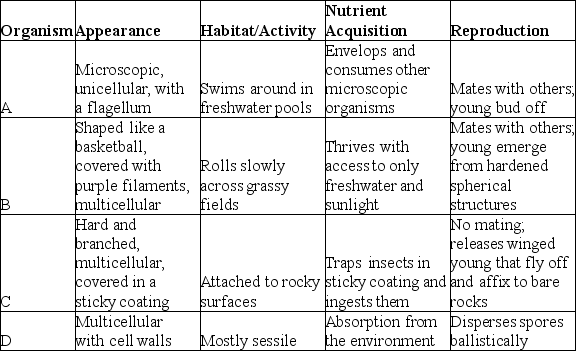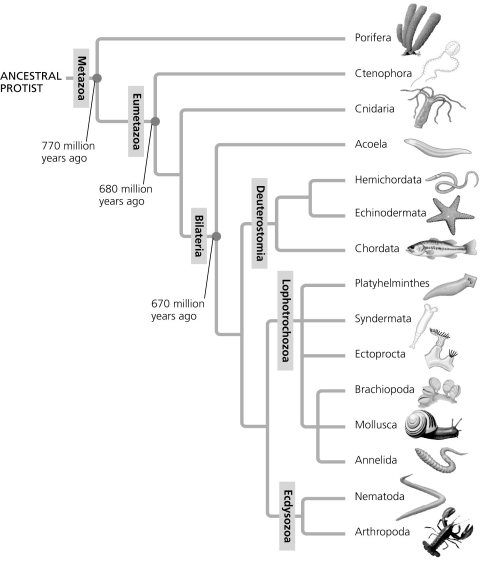A) nervous-mesoderm
B) muscular-ectoderm
C) stomach-mesoderm
D) skin-ectoderm
Correct Answer

verified
Correct Answer
verified
Multiple Choice
Use the table to answer the following question.
 A researcher is studying animals on a previously undiscovered island, home to many unfamiliar organisms, and decides to survey them using the research equipment at hand. The researcher observes them in detail, and makes the notations shown in the table.
Which of the organisms listed is most likely to contain genes encoding enzymes that can fix carbon from CO2?
A researcher is studying animals on a previously undiscovered island, home to many unfamiliar organisms, and decides to survey them using the research equipment at hand. The researcher observes them in detail, and makes the notations shown in the table.
Which of the organisms listed is most likely to contain genes encoding enzymes that can fix carbon from CO2?
A) organism A
B) organism B
C) organism C
D) organism D
Correct Answer

verified
Correct Answer
verified
Multiple Choice
While observing seawater through a microscope, you spot the embryo of an unknown animal. Which of the following criteria could you use to determine whether the organism exhibits protostome or deuterostome development?
A) the development of germ layers
B) spiral cleavage or radial cleavage
C) the development of a blastopore
D) the development of an archenteron
Correct Answer

verified
Correct Answer
verified
Multiple Choice
Use the figure to answer the question.  Which of the following statements is consistent with the phylogeny in the figure?
Which of the following statements is consistent with the phylogeny in the figure?
A) Deuterostomia evolved before Porifera.
B) Ecdysozoa evolved before Deuterostomia.
C) Porifera are more closely related to Acoela than they are to Ctenophora.
D) Porifera are more closely related to Ctenophora than they are to Acoela.
Correct Answer

verified
D
Correct Answer
verified
Multiple Choice
Which of the following characteristics is common to all known animals?
A) Animals are unicellular.
B) Animals are multicellular.
C) Animals are autotrophic.
D) Animals have cell walls.
Correct Answer

verified
Correct Answer
verified
Multiple Choice
Which of the following statements is correct regarding animal body plans?
A) organisms direct their own evolution in order to maximize their success
B) animals evolve according to a pre-ordained plan
C) the body plans we see now have been evolutionarily advantageous compared to others in the past
D) mutations have arisen that allow only some shapes to be produced
Correct Answer

verified
Correct Answer
verified
Multiple Choice
Use the information to answer the question. One small animal phylum (Placozoa) contains only two species, Trichoplax adhaerens (T. adhaerens) and T. reptans. There are four types of cells, none of which are nerve or muscle cells, and none of which have cell walls. T. adhaerens sperm cells have never been observed. Embryos up to, but not past, the 64-cell (blastula) stage have been observed. On the basis of information in the paragraph, which of these should be able to be observed in T. adhaerens?
A) a coelom
B) the process of gastrulation
C) eggs
D) a radially symmetric larval form
Correct Answer

verified
Correct Answer
verified
Multiple Choice
Which of the following factors most likely contributed to the extinction of many Ediacaran life forms?
A) predation by new species, poisoning from high carbon dioxide levels, and loss of developmental flexibility
B) predation by new species, poisoning from high oxygen levels, and loss of habitat due to increased temperatures
C) predation by new species, faster movement by new species, and increased developmental flexibility by new species
D) loss of habitat due to increased temperatures, poisoning from high oxygen levels, and loss of developmental flexibility
Correct Answer

verified
Correct Answer
verified
Multiple Choice
In the earthworm body plan, the digestive system can be described as a "tube-within-a-tube." Where would you expect to find most of the tissues that developed from endoderm?
A) lining the straw
B) lining the space between the pipe and the straw
C) forming the outside of the pipe
D) forming the outside of the straw
Correct Answer

verified
Correct Answer
verified
Multiple Choice
Which of the following organisms is most likely classified as something other than an animal?
A) sponge
B) coral
C) jellyfish
D) choanoflagellate
Correct Answer

verified
Correct Answer
verified
Multiple Choice
Suppose a researcher for a pest-control company developed a chemical that inhibited the development of an embryonic mosquito's endodermal cells. Which of the following best explains the effectiveness of the pesticide?
A) The mosquito would develop a weakened exoskeleton that would make it vulnerable to trauma.
B) The mosquito would have trouble digesting food, due to impaired gut function.
C) The mosquito would have trouble with respiration and circulation, due to impaired muscle function.
D) The mosquito wouldn't be affected at all.
Correct Answer

verified
B
Correct Answer
verified
Multiple Choice
Which of the following is a feature of the digestive tube in most animal phyla?
A) The outer tube consists of a hard exoskeleton.
B) The outer tube consists of digestive organs.
C) The mouth and anus form the ends of the inner tube.
D) The two "tubes" are separated by tissue that comes from embryonic endoderm.
Correct Answer

verified
Correct Answer
verified
Multiple Choice
Which of the following statements regarding the diversification of animals is supported by the current available evidence?
A) most animals belong to the clade Bilateria
B) animals descended from multiple ancestors
C) ctenophores are basal metazoans
D) sponges are a paraphyletic group of organisms
Correct Answer

verified
Correct Answer
verified
Multiple Choice
In individual insects of some species, whole chromosomes that carry larval genes are eliminated from the genomes of somatic cells at the time of metamorphosis. As a result of the chromosome loss, which of the following consequences is most likely?
A) cloning a larva from the somatic cells of such an adult insect would be difficult
B) such species must reproduce only asexually
C) sequencing of the entire genome will not be possible
D) metamorphosis can no longer occur among the descendants of such adults
Correct Answer

verified
Correct Answer
verified
Multiple Choice
Which of the following characteristics is unique to animals?
A) the structural carbohydrate, chitin
B) nervous system signal conduction
C) heterotrophy
D) flagellated gametes
Correct Answer

verified
Correct Answer
verified
Multiple Choice
Which of the following environmental changes is thought to have contributed to the Cambrian explosion?
A) a decrease in oxygen levels in the atmosphere
B) an increase in carbon dioxide levels in the atmosphere
C) an increase in oxygen levels in the atmosphere
D) a large meteor impact that spread ash into the atmosphere
Correct Answer

verified
Correct Answer
verified
Multiple Choice
Which of the following was probably an important factor in bringing about the Cambrian explosion?
A) the movement of animals onto land
B) an increase in the concentration of atmospheric nitrogen
C) the emergence of predator-prey relationships
D) the origin of bilaterian animals
Correct Answer

verified
Correct Answer
verified
Multiple Choice
Sponges and ctenophores have both been proposed as basal metazoans. Which of the following types of data support the idea that sponges are the basal group?
A) sequences of cadherin genes, cleavage type, structure of collar cells, and bilateral symmetry of adults
B) sequences of collagen genes, bilateral symmetry of adults, cleavage type, and fossil steroids
C) recent phylogenomic evidence, fossil steroid evidence, molecular clock, lack of tissues in sponges, and structure of collar cells
D) structure of collar cells, bilateral symmetry of larvae, sequences of cadherin genes, and molecular clock
Correct Answer

verified
Correct Answer
verified
Multiple Choice
Body symmetry in animals affects swimming in which of the following ways?
A) Radial symmetry is more advantageous for active swimming than is bilateral symmetry.
B) Radial symmetry occurs most frequently in animals that catch their prey by rapid swimming.
C) Bilateral symmetry allowed animals to evolve nerves.
D) Bilaterally symmetric animals can be streamlined for swimming, but radially symmetric animals cannot.
Correct Answer

verified
D
Correct Answer
verified
Multiple Choice
You find a new species of worm and want to classify it. Which of the following lines of evidence would allow you to classify the worm as a nematode and not an annelid?
A) It is segmented.
B) It is triploblastic.
C) It has a coelom.
D) It sheds its external skeleton to grow.
Correct Answer

verified
Correct Answer
verified
Showing 1 - 20 of 58
Related Exams